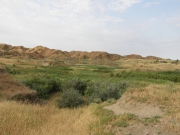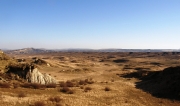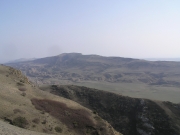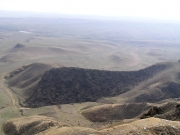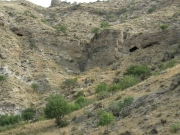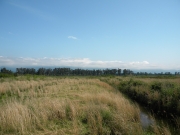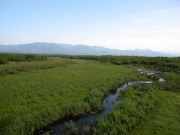Short-toed Eagle Circaetus gallicus Gmelin, 1788
Subspecies: Monotypic, no subspecies
Georgian name: ძერაბოტი [dzeraboti]
The Short-toed Eagle has a wide distribution, depending on the abundance and availability of reptiles, mostly snakes. Occurs from southwestern Europe (Spain, France), northwest Africa (Morocco, Algeria, Tunisia, Libya) along the Mediterranean shore (Italy, Greece), in eastern regions (Hungary, Slovakia, Bulgaria, Romania) north to the Belarus and sporadically to Gulf of Finland, and across southern part of European Russia (across Volga basin and Ural (up to 52 northern latitude) east to northern Kazakhstan (up to 49 northern latitude) and Central Asian countries; breeds in Turkey, Georgia, Azerbaijan, Armenia, Syria, Lebanon, Israel and Iran. Sedentary populations occur on the Indian Subcontinent and in Southeast Asia (Lesser Sunda Island). Western populations of the short-toed snake-eagle are migratory. Most spend the winter in in the Sahel zone of sub-Saharan Africa, but small number remains in southern Spain. Birds from eastern populations are year-round residents (Dement’yev & Gladkov, 1951; Fergusson-Lees & Christie, 2001; Forsman, 1999; Gensbol, 2004; Mebs & Schmidt 2006).
Status of presence: The Short-toed Eagle is rare migratory breeder in Georgia and widespread and regular, but in small numbers, passage migrant across country.
Distribution and habitats: The Short-toed Eagle uses a wide range of habitats – light forests, various woodlands in low altitudinal belts, arid grassland, semi-savannah, semi-desert, mountain steppe. It generally prefers mixed habitat that combines open areas, rich in reptile prey, with tree cover for nesting. There are the most optimal conditions for the species breeding in the study territory in the South-East of Georgia and along borders of Azerbaijan. Here, in Mtkvari River valley, not high (from 300-400 to 800-1000 meters above the sea level), strongly eroded and slightly afforested ranges, ridges plateau, are divided and dismembered by wide plain lowering, former and dry river-beds of seasonal flows, canyons, ravines. The breeding habitats are attached to the fragments of the saved arid sparse forests (Savanna type), mainly juniper-pistachio-pine, alternated with open plots and “tugai”-type forests in flood-lands of the largest rivers of the region – Mtkvari, Alazani, Iori, Khrami. The most optimal habitats for the Short-toed Eagle breeding occupy in Georgia comparatively small area – from 5600 to 5800 sq. km. The species can be found rarely on wooded mountainous slopes. For more detailed information see Abuladze, Beruchashvili, 2012.
Population size: According to unpublished data provided by Georgian zoologists, working in 1930’s-1960’s, the Short-toed Eagle was widespread and more-or-less common raptor species in arid areas of Eastern Georgia. At the middle of 1970’s their number dropped catastrophically owing to excessive use of pesticides in agriculture and as result of sharp degradation of the reptiles populations. In 1970’s the Short-toed Eagle was one of the most rare breeding birds of prey in Georgia and we estimated its number at 4-7 pairs (Abuladze, 1985), distributed mostly in semi-deserts along the south-eastern borders of country. Little-visible increase of number was begun since the second half of 1980’s, when in Georgia there were according to Authors’ estimations already up to 10 pairs (Abuladze, 1997), 10-12 pairs in the early 1990’s, about 15 pairs in late 1990’s, up to 20 in 2001-2006 (Abuladze, 2006).
4-8 pairs in 1970’s – early 1980’s, about 10 breeding pairs in the beginning of 1990’s, about 14 pairs in the first half of 1990’s and 15-20 pairs were nested in Georgia in 2001-2006.
The largest breeding group of the Short-toed Eagle if central parts of Southern Caucasus at present occurs in Eastern Georgia Western Azerbaijan, i.e. in the Caspian Sea basin, and numbers of breeding pairs decrease to West and North. According to Author’s expert estimation, in 2008-2012 the number of breeding pairs of the Short-toed Eagle compiled at least 20 and slowly continued to grow (Abuladze, 2008a). At the present time within the limits of Georgia there are at least twenty-five breeding pairs, probably up to thirty pairs: at Iori table-land – 8-10 pairs, at least four pairs were counted in lower part of right-side of Alaszani River’s flood-lands (along the frontier with Azerbaijan) in springs/summers 2003, 2004 and 2007; at least two pairs regularly nested in 2004-2012 at Kvernaki Ridge, Shida Kartli region; three occupied territories were identified in summer 2001, in 2010-2011 in watershed part of Trialeti Ridge, Lesser Caucasus; the presence of one breeding pair was confirmed by regular observations during summer 2001 in NW part of Tsalka Hollow. It should be noted that in 1970’s – 1980’s this bird was not registered. Breeding of 1, probably of 2 pairs, was confirmed in southern part of Gombori Ridge, Kakheti Region. Occupied territories were identified here in July 1999 and in May 2012. Sporadically single breeding pairs can be discovered in other points of Eastern Georgia, sometimes in direct neighbourhood with settlements. So, breeding of one pair was recorded in 1996 in northern surroundings of Tbilisi City, near Tbilisi reservoir. Nest of this pair was found after fledging of young. Nest was located on Eldari Pine, on branch in central part of crown at the height 6.3 meters above ground. Inspite of negihbourhood of road with intensive traffic (about 100 meters) and permanent presence of people near, the pair could successfully rear up an offspring. Thus the total number of breeding population compiles in the last years in Georgia at least 25 pairs with an average density at 4.0-4.5 pairs at 1000 sq.km. Several times these raptors were recorded during breeding seasons in Western Georgia, i.e. in the Black Sea basin, but in all cases were observed solitary individuals (Abuladze, Beruchashvili, 2012).
At least 20 pairs of Short-toed Eagle were nested along the western frontiers of Azerbaijan in the first half of 1980’s. Later we did not conduct studies in Azerbaijan, but in our opinion, numbers of this raptors in western part of Azerbaijan during last two decades – from the late 1980’s by the present time at least has doubled. Thus by the present time in central parts of South Caucasus – in Eastern Georgia and in western part of Azerbaijan, the breeding group of the Short-toed Eagle was formed with number at 60-70 pairs, that according to our opinion is the limital for the this species.
Breeding biology: The birds, breeding in the study area in spring arrive in the 1st decade of April and just after that occupy nesting plots beginning to repair old nests or build new nests. The first observations of the formed pairs are recorded in different years at breeding sites 2-9 April and directly at near nests or on nests from 4 to 11 April. The breeding display flight continue entire April, but sometimes they can be observed even later – until the middle of June.
Totally for the period of field works 43 breeding plots were revealed, where in different years it was discovered investigated and described 14 nests of the Short-toed Eagle, 11 breeding case traced, 5 clutches explored, reasons of death of 16 birds were determined.
Among 14 nests discovered by us, 12 nests were built by birds themselves, in two cases the pairs occupied old nest-sites of Carrion Crow. All known nests were located in trees, and preference was given to pine and junipers. 7 nests were in Eldari Pines (Pinus eldarica), 3 nests were in various junipers (Juniperus spp.) by one – in White Poplar (Populus alba), Pistachio-tree (Pistacia atlantica subsp.mutica), oak (Quercus spp.) and acacia (Acacia spp.). Ten nests were located in upper parts of crowns and five nests were on lateral branches, but in all cases nests were open from above. Nests in pines and junipers were situated closer to open habitats while nests in deciduous trees were located farer from open spaces. 9 out of 14 nests were placed in pines and junipers, grown on very steep terrace-like slopes or precipices The average height of nests above ground was about 6.5 meters, ranged from 4.5 to 14.0 meters above ground. All nests discovered by us were very well masked and it was very difficult to discover them especially new ones built in that year Many works speak about high extent of hiddenness of the Short-toed Eagle nests in other regions too Always the Short-toed Eagle nests are well hidden from eyes and badly seen from below or from the sides. More detailed data on nest-sites selection presented in Table 12-1.
Table 12-1. Nest data of Short-toed Eagle in Georgia (n = 9) and western Azerbaijan (n = 5)
| Nest-tree | Position in tree | Height above ground, meters | Number of nests | |||
| crown | branch | <5 | 5-10 | 10-15 | ||
| Eldari Pine, Pinus eldarica | 5 | 2 | – | 6 | 1 | 7 |
| Junipers, Juniperus spp. | 2 | 1 | 1 | 2 | – | 3 |
| Phistachio, Pistacia mutica | – | 1 | – | 1 | – | 1 |
| Oak, Quercus spp. | 1 | – | – | – | 1 | 1 |
| Acacia, Acacia spp. | 1 | – | – | – | 1 | 1 |
| White Poplar, Populus alba | 1 | – | – | – | 1 | 1 |
| Total: | 10 | 4 | 1 | 9 | 4 | 14 |
The sizes of known 14 nest-sites were as following: outer diameter was usually 70-75 (11 nests of 14) cm, ranged from 60 to 100 cm; height of nests was from 25 to 60 cm, more often 30-40 cm. Old, occupied in previous years, nests were of a more large size. The dominate components of nest materials were dry twigs of trees and bushes with thickness from 0.5 to 3 cm. The inner diameter of nest-sites ranged from 25 to 35 cm. Cup always is lined with small fresh branches of juniper, pine or poplar. As a rule, by the end of breeding the nest-cups are lined with thick layer of dry desintergrate pellets casted by chick directly in the nests under their feet. Near nests always there are several perches, placed on dry twigs under which it is always possible to find the food remains.
Pair formation and courtship flights were observed in the second half of April, but several times courtship flights were watched later – before the middle of May. The copulations directly on the nests or near nests were observed in Georgia two times – on 4 April 1988 in Vashlovani Nature Reserve and on 14 April 1999 at Udabno Ridge; besides that, copulation was registered on April 7, 1974 at northern slope of Bozdag Ridge in Western Azerbaijan.
Egg-playing takes place in the second half of April, usually during last decade of April, probably during first decade of May. The duration of incubation for two clutches was 46 days (26 April – 10 June) and 47 days (21 April – 6 June).
The hatching was recorded in the second – third pentades of June and fledging in the late July. But feeding of the fledged young by adults was observed still 2 August 1989 directly on nest, 7 August 2002, 9 August 1991 and 14 August 2011 near the nests. The broods on breeding plots stay usually till the middle of August, and sometimes till the end of August. During the post-breeding movements, the broods move in habitats rich by reptiles where they stay till the beginning of autumn departure. The most preferred habitats during post-breeding movements are semi-desert, but sometimes they stayed before departure in uncommon habitats. For example, these birds regularly were observed at heights from 1600 to 2300 meters above the sea level in wet habitats at sub-alpine meadows of Lesser Caucasus, where the number and density of small reptiles, mostly rock lizards and amphibians are high.
The sizes of five eggs from five nests of white or dirty-white colors were the following: 74.8 х 58.0 mm; 77.0 х 59.0 mm; 74.5 x 58.3 mm; 73.7 х 58.5 mm; 74.0 х 58.3 mm. In all known clutches there was 1 egg of white color. The breeding success was estimated for 11 cases of nesting and compiled in the average some more than 0.7 fledged per one breeding pair or 72.7%, eight young were fledged. In one case clutch was robbed by Corvids. Egg was pecked out by the Black-billed Magpie, Pica pica, pair, when incubating female was flushed from the nest by shepherds. The behavior of pairs during the whole breeding season may be characterized as extreme careful. During people approach to nest they leave the nest at 50-70 meters, hiding from the point of view or soar at the great altitude at distance 100-300 meters from nests and sometimes more distance. Later, before chick hatching, they can allow people come closer but anyway they are very careful to relation to approaching observer. The Short-toed Eagle patiently relates to the neighborhood of other birds of prey. At the distance of 100-500 meters from the nests of Short-toed Eagle’s nests, occupied nests of other raptor species – Honey Buzzard, Cinereous Vulture, Common Buzzard and Long-legged Buzzard, were found. In one case the Short-toed Eagle nest was located in neighbourhood at about 20 meters, from the large colony of the Spanish Sparrow (Passer hispaniolensis). In other case, in April 1983 at the south-eastern edge of Iori Table-land (Kakheti region, SE Georgia), the pair began to build the nest in acacia in artificial field-protective plantation near to colony of 220-240 pairs of the Rosy-colored Starling (Sturnus roseus), but, unfortunately, birds were frighten by shepherds and leave almost finished nest.
Diet: About 380 prey items were collected during field works on nests.
Prey is often brining in bill semi-swallowed and quite often reptiles are still alive. The size of oval pellets is 45-55 x 25-30 mm. The pellets consist of scales abdominal thorax of reptiles. During our observations, the Short-toed Eagle feeding remained unstudied in general, because near 4 nests out of 11 discovered nests 11, any food remains have not been found. However on and around other 7 nests as well as under perches within the limits of hunting territories of pairs, pellets and prey remains were collected, totally 153 items of prey, whose analysis has shown that the main prey of Short-toed eagle in Georgia and in adjacent parts of South Caucasus are reptiles, mostly small and medium sized species. By occurrence the dominated lizards belonged to genus Lacertidae. Among the prey remains the Striated or Caspian Green Lizard (Lacerta strigata), Balkan Green Lizard (Lacerta trilineata), young individuals of Zheltopusik or European Legless Lizard (Ophysaurus apodus), young individual of unidentified Elaphe (Elaphe spp.), and also amphibians – Green Toad (Bufo viridis) and Lake Frog (Rana ridibunda) were identified. Besides that, in some pellets there was fell of the small rodents, and also feathers of unidentified small passerine birds.
The breeding birds begins hunting usually late in the morning, more often from 10:00, after the ground have warmed and reptiles are active.
Seasonal movements: The spring passage across eastern part of Georgia takes place from the late March to the middle of April with a peak in the middle of April. The extreme dates were March 23 and May 11. Most of migrants, about 2/3 of total number, were counted between April 10 and 20.
At the Black sea coastlands of Georgia, the dates of spring passage are more expanded, the birds stay there until the middle of May.
The autumn passage starts at the middle of August with a peak at the middle of September. The passage Short-toed Eagles might be sighted in open habitats practically everywhere – from the Black Sea shore to semi-deserts and subalpine meadows of the Great Caucasia and South-Georgian Plateau Only on the steep mountain slopes covered by solid forests these birds of prey were not recorded . As a whole the number of passage birds in not great and compiles of the total number of passage birds of prey in different years and in different points of South Caucasus for all years of observations compiles only 0.53 % in spring – with annual fluctuations from 0.05% and to 1.54% and about 0.31% in autumn with annual fluctuations from 0.09% and to 0.47% of the total number of the counted passage birds of prey (Abuladze, 1998; Abuladze, Beruchashvili, 2012; Abuladze, Edisherashvili, 2003; Abuladze, Kandaurov, Eligulashvili, 2011; Jansen, 2011; Verhelst, Jansen, Vansteelant, 2011).
Threats and limiting factors: Unfortunately, in spite of legislative protection, Short-toed Eagle sometimes often suffers from poachers. During the years of the study, at least 16 cases of illegal shooting at the territory of Georgia were noted (Abuladze et al. 2011). Most of cases, 12 of known 16, were recorded during the autumn passage and one in spring. Unfortunately, killing of two adult individuals and one fledged young were recorded in August 1996 in western part of Iori Table-land, in southeastern part of Georgia.
Conservation status: SPEC 3; CEE 1; BERNA 2; BONN II; CITES II; AEWA; Status IUCN/BirdLife – Least Concern (LC); Status Global Raptor Information Network – Lower risk.
Species was including in the first edition of the “Red Data Book of the Georgian SSR” (1982).
